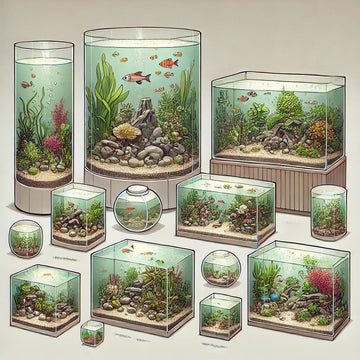How to choose the right aquarium size? Think about the future and the comfort of the fish!
One of the most common questions we receive from customers is "What size aquarium should I buy?" Unfortunately, there is no easy answer to this question. Choosing the right size aquarium depends on several factors, such as the species of fish, planned decoration, indoor location and maintenance.
In this article, we will advise you on how to choose the right aquarium so that you avoid compromises while creating a healthy and aesthetically pleasing environment for your aquatic inhabitants.
Think of aquarium life as a first place!
Before we get into the details of choosing the size of your aquarium, it's important to remember that you will get the most enjoyment out of your aquarium when you create ideal conditions for its inhabitants .
✅ The closer to nature, the better - Fish and other aquarium animals need a stable and natural environment to be healthy and active. The more space you give them, the less stress they will have.
✅ Stable water quality - A larger aquarium means more water, which helps maintain stable parameters and prevents sudden fluctuations that can endanger the health of the fish.
✅ Natural fish behavior - The aquarium should be large enough for the fish to swim naturally and for each animal to find its own space.
✅ Fewer problems in the future – It often happens that after a few months, owners want to add new fish, plants or decorations, but this is no longer possible with a small aquarium. Choosing a larger aquarium right from the start will avoid later compromises.
Why is a bigger aquarium better?
If you're not sure what size to choose, the general rule is: the bigger, the better . And here's why:
✅ Greater flexibility - Many aquarists eventually realize that their aquarium is too small for new decorations, more fish, or plants.
✅ Easier maintenance – The more water in the aquarium, the more stable the environment for the fish. A larger volume of water helps maintain better water quality and reduces fluctuations in parameters.
✅ More stable environment for fish - More water means better waste distribution and less fluctuations in water chemistry .
✅ More room for creativity - A larger aquarium allows for more interesting hardscape compositions and better conditions for plants.
Important factors when choosing aquarium size
1️⃣ What types of fish or other animals do you want to keep?
- Small fish (tetras, guppies, razbory, shrimp): 20–60 liters is enough.
- Medium-sized fish (angelfish, rainbowfish, smaller cichlids): From 100 liters and above .
- Large fish (cichlids, discus, catfish): Minimum 200–300 liters .
❌ Bad examples :
- A 30 liter aquarium for cichlids will not be enough.
- A 300 liter aquarium for a couple of shrimp is unnecessarily large.
2️⃣ Where will you place the aquarium?
- The aquarium should be on a solid surface and out of direct sunlight.
- Corner aquarium or classic? If you are planning aquascaping, we recommend a classic rectangular aquarium.
3️⃣ What style of aquarium are you planning?
- Community aquarium with multiple fish species? A larger aquarium is better.
- Aquascaping ? We recommend a wider aquarium (min. 50 cm deep) so you can work with perspective.
Types of aquariums by shape
✔ Rectangular aquarium – the most practical, ideal for aquascaping.
✔ Cube aquarium – suitable for nano aquariums.
✔ Corner aquarium – saves space, but less room for creativity.
✔ Tall aquarium – suitable for specific habitats, but harder to handle.
❌ Ball aquariums - unsuitable for fish, bad for filtration and space.
Summary – How to choose the right aquarium size?
🔹 Start by asking what kind of fish and decorations you are planning.
🔹 The larger the aquarium, the more stable the environment and the easier the maintenance.
🔹 Choose according to location and style - classic rectangular aquariums are the best choice.
🔹 Think about the inhabitants of the aquarium - if you create the best possible environment for them, they will be healthier and happier.
💡 Final tip: If you can't decide between two sizes, choose the larger one - in aquariums, extra space is always useful!

